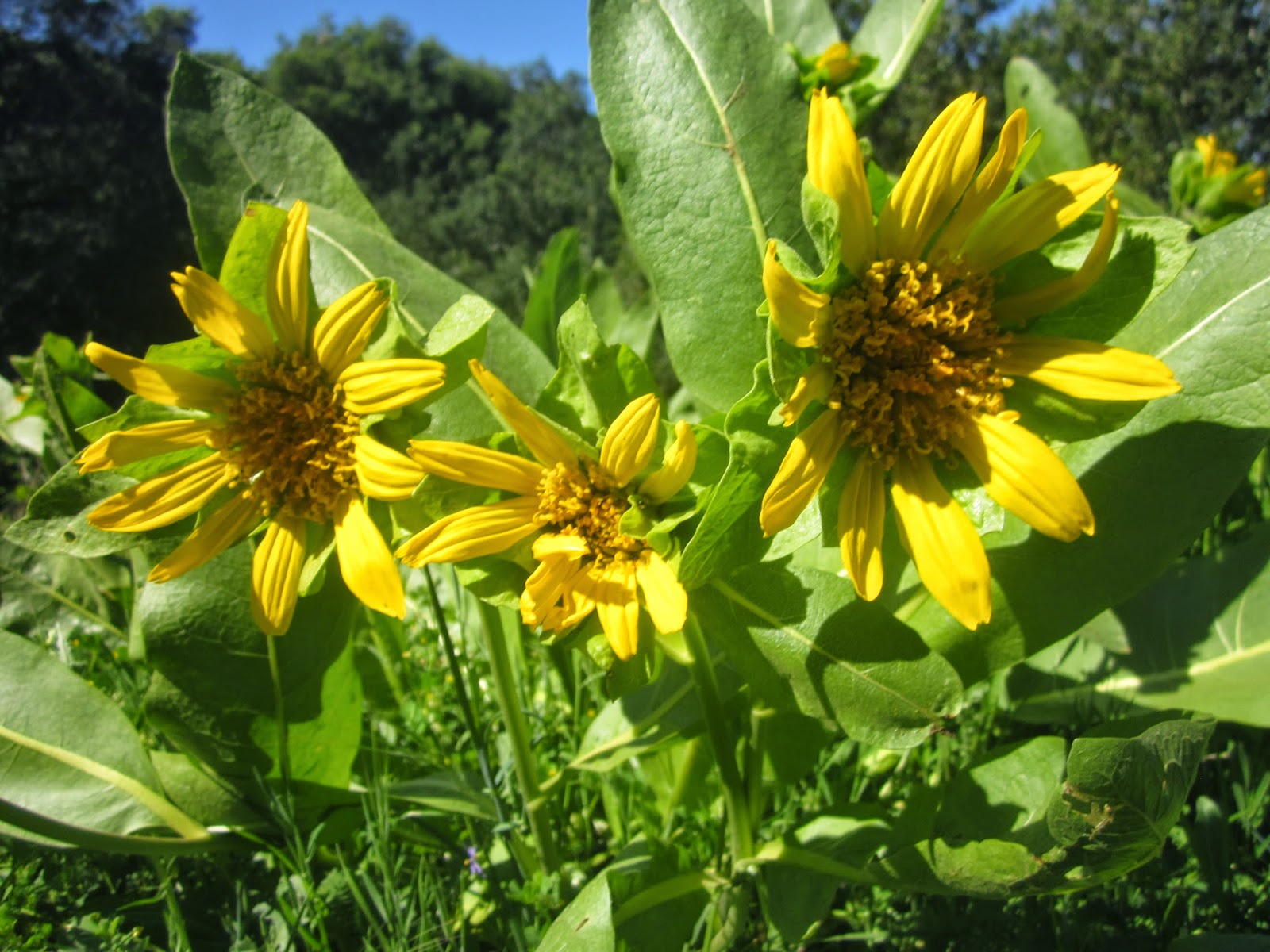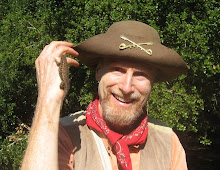Despite the recent rain, the waterfalls at Uvas Canyon County Park were below normal for this time of year. My De Anza College class assembled at the visitor parking lot at 10 am and then headed up the road and began our 5.2 mile walk by way of the Waterfall Loop Trail.
Along Uvas Creek we paused to examine at least five species of ferns as well as big-leaf maple, Douglas fir, bay laurel, and alder trees. I caught a young alligator lizard and put it in my hat. We saw many species of wild flowers, including red larkspur, two-eyed violet, chaparral pea, yerba santa, golden yarrow, morning glory, and blue gilia. We took short side trips to view Black Rock Falls, Upper Falls, and Basin Falls.
After the Hot House Site, we crossed the creek and headed east on the Contour Trail and then right on the Alec Canyon Trail where we stopped for lunch at Manzanita Point. Some of us enjoyed the sight of a roosting hummingbird while we ate lunch and admired the view of the Diablo Range to the east. After lunch we continued on to Triple Falls, which one of the students quipped should be known as "Trickle Falls" because of the drought. On the way back some of us saw a baby rattlesnake crossing Alec Canyon Trail.
TO GET THERE... From Highway 101 south from San Jose, take Bailey Avenue west and McKean Road (which turns into Uvas Road) south, and then turn right (west) on Croy Road to the park.
Saturday, April 11, 2015
Sunday, April 5, 2015
A Spring Hike at Almaden Quicksilver County Park
Despite the drought there were lots of wildflowers on display yesterday at Almaden Quicksilver County Park. My College of San Mateo class gathered at the Hacienda entrance on the southeast end of the park. In the nineteenth century this was where a heavy red rock called cinnabar was hauled down the mountain from the mines for the extraction of mercury. From 1846 until 1975 mercury was mined from these hills.
Our hike of more than six miles began with a steady uphill ascent on the Mine Hill Trail, where we paused frequently to watch acorn woodpeckers and to see many beautiful wild flowers, including brodiaea, buttercup, fiesta flower, larkspur, globe lilly, lupine, Indian paintbrush, sticky monkey flower, clematis, wild onion, Douglas iris, and big-leaf maple in bloom.
We continued on the Mine Hill Trail to a short side trip to the San Cristobal Tunnel, which was excavated in 1866. This is the only mine in the park open to the public. After inspecting the tunnel interior we stopped for lunch. A horizontal mine is called a tunnel. A vertical mine is called a shaft.
After lunch we continued to the intersection of the Mine Hill Trail and the Castillero Trail, where we stopped to appreciate a beautiful view of Mount Umunhum and Loma Prieta, which is the highest peak in the Santa Cruz Mountains. Heading east on the Castillero Trail, we stopped to inspect serpentine rock and then continued to the abandoned rotary furnace, where cinnabar was heated to separate mercury during the mining period. Ditches were installed to try to prevent mercury from flowing from the furnace to the Guadalupe River. Old mining furnaces like this are among the main sources of mercury contamination in San Francisco Bay.
We then turned north on the Yellow Kid Trail and stopped to examine the relics of English Town, where Cornish miners lived in the nineteenth century. It is amazing how quickly the works of man disappear after they are abandoned to the elements. From English Town it is a steep descent on the Deep Gulch Trail back to the parking lot at Hacienda. After the hike some of us stopped at the mining museum at Casa Grande in the town of New Almaden. Here you can touch and hold a piece of cinnabar. This ten thousand square foot house, built in the 1850's was once the home to mining superintendents.
TO GET THERE... From Highway 85 take the Almaden Expressway turnoff and head south. Turn right on Almaden Road for about three miles to the
Hacienda Trail head parking lot.
Our hike of more than six miles began with a steady uphill ascent on the Mine Hill Trail, where we paused frequently to watch acorn woodpeckers and to see many beautiful wild flowers, including brodiaea, buttercup, fiesta flower, larkspur, globe lilly, lupine, Indian paintbrush, sticky monkey flower, clematis, wild onion, Douglas iris, and big-leaf maple in bloom.
We continued on the Mine Hill Trail to a short side trip to the San Cristobal Tunnel, which was excavated in 1866. This is the only mine in the park open to the public. After inspecting the tunnel interior we stopped for lunch. A horizontal mine is called a tunnel. A vertical mine is called a shaft.
After lunch we continued to the intersection of the Mine Hill Trail and the Castillero Trail, where we stopped to appreciate a beautiful view of Mount Umunhum and Loma Prieta, which is the highest peak in the Santa Cruz Mountains. Heading east on the Castillero Trail, we stopped to inspect serpentine rock and then continued to the abandoned rotary furnace, where cinnabar was heated to separate mercury during the mining period. Ditches were installed to try to prevent mercury from flowing from the furnace to the Guadalupe River. Old mining furnaces like this are among the main sources of mercury contamination in San Francisco Bay.
We then turned north on the Yellow Kid Trail and stopped to examine the relics of English Town, where Cornish miners lived in the nineteenth century. It is amazing how quickly the works of man disappear after they are abandoned to the elements. From English Town it is a steep descent on the Deep Gulch Trail back to the parking lot at Hacienda. After the hike some of us stopped at the mining museum at Casa Grande in the town of New Almaden. Here you can touch and hold a piece of cinnabar. This ten thousand square foot house, built in the 1850's was once the home to mining superintendents.
TO GET THERE... From Highway 85 take the Almaden Expressway turnoff and head south. Turn right on Almaden Road for about three miles to the
Hacienda Trail head parking lot.
Subscribe to:
Comments (Atom)















